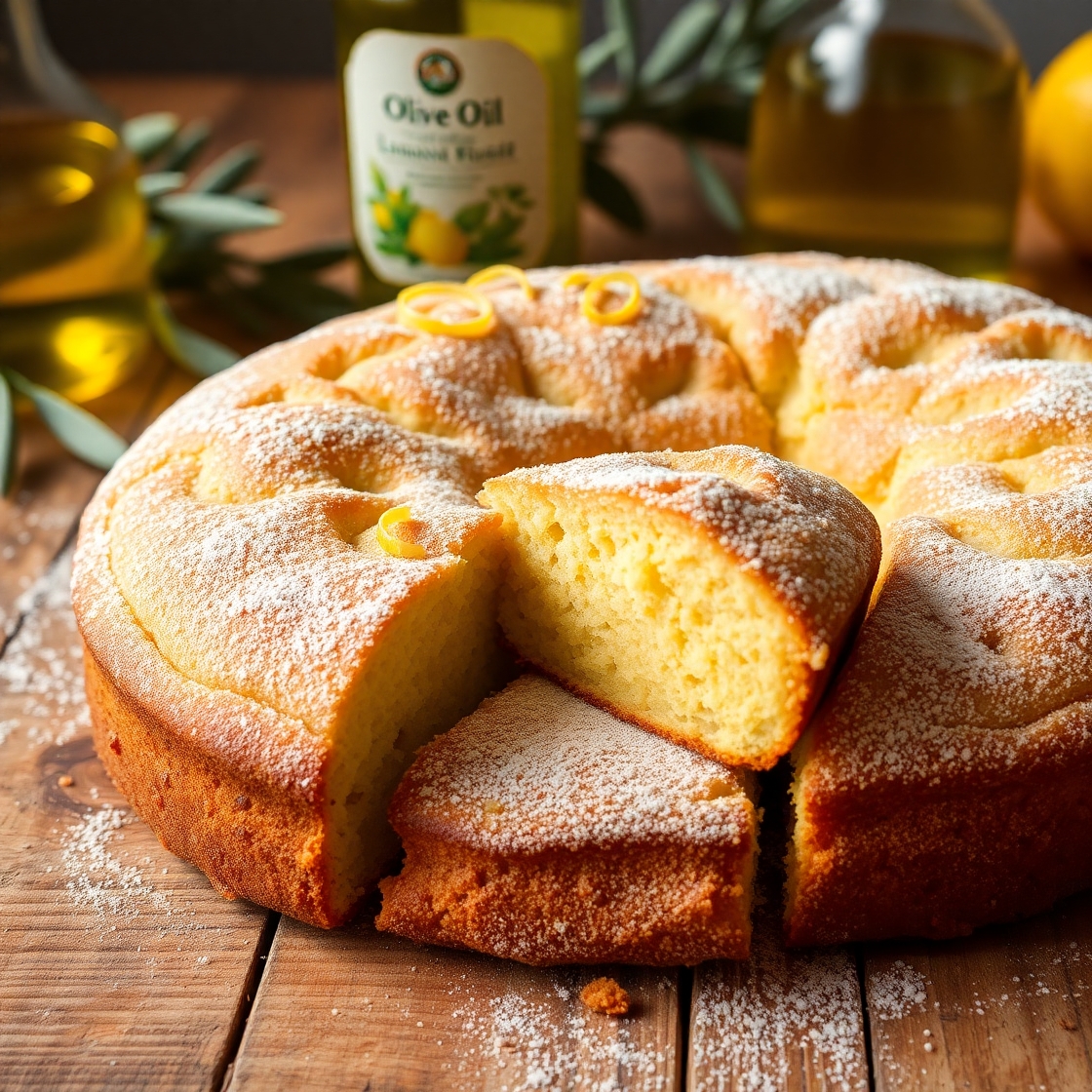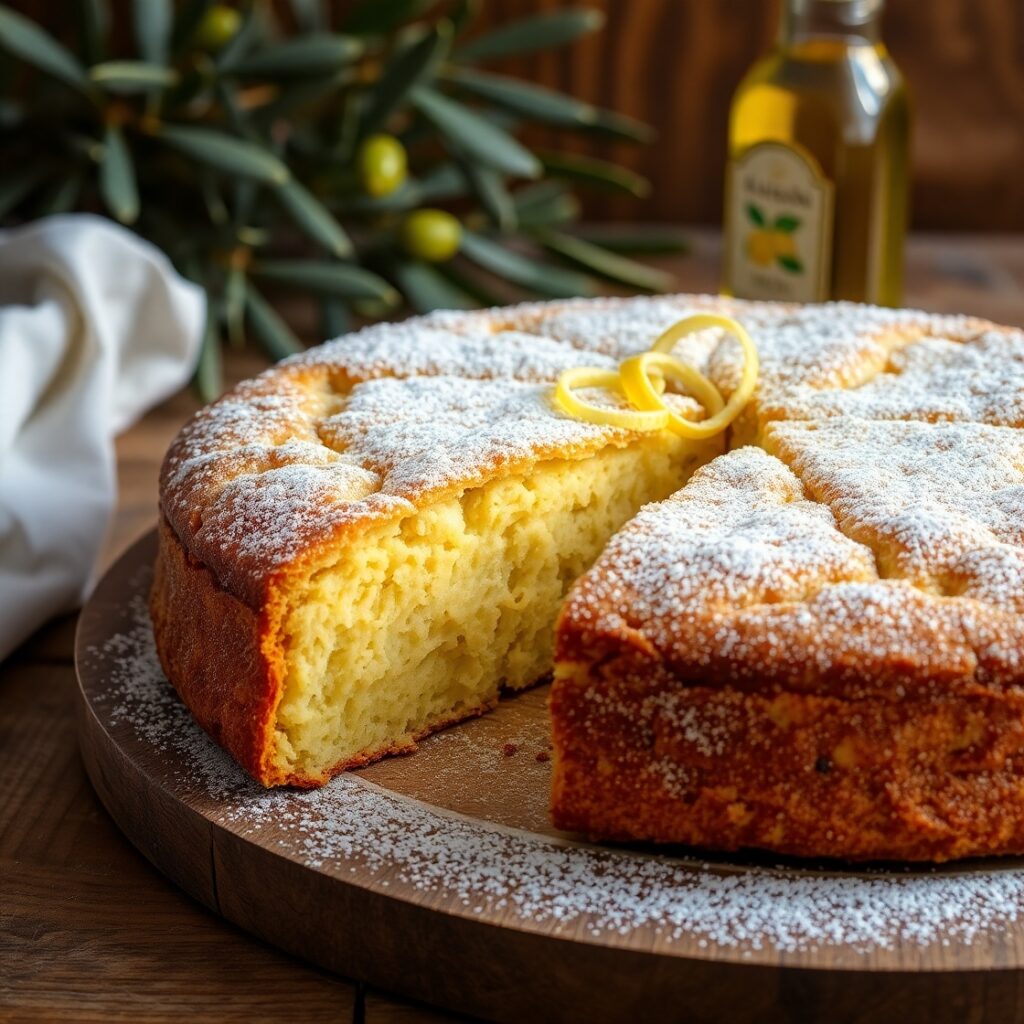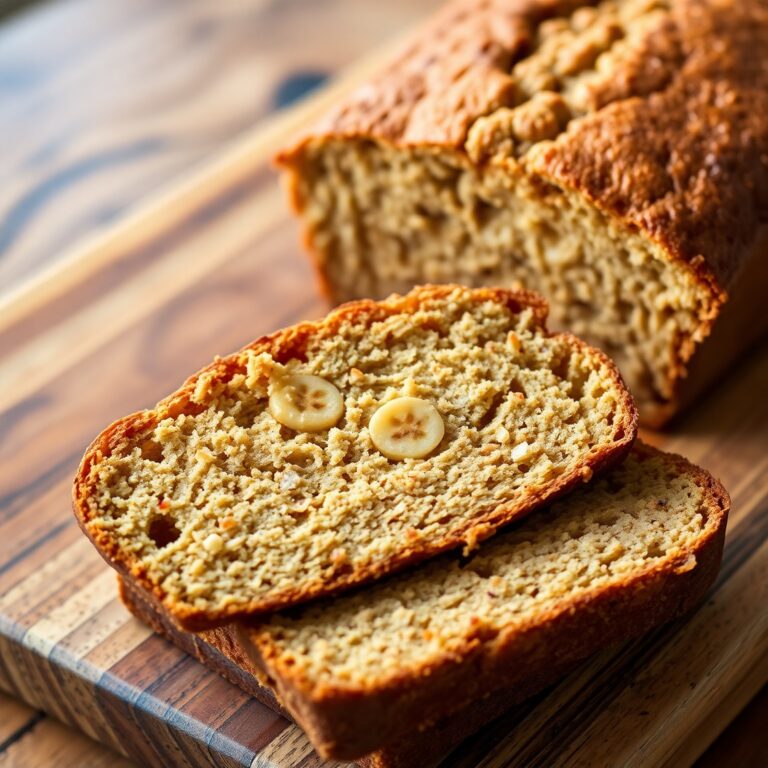
There’s something timeless about a slice of olive oil cake.
Maybe it’s the way the golden crust gives way to a moist, delicate crumb. Or how the subtle fruitiness of olive oil lingers long after the last bite.
This recipe was born out of a desire to make a dessert that’s simple, elegant, and just a little different. While butter often takes center stage in baking, I wanted to highlight olive oil—an ingredient that’s been treasured in Mediterranean kitchens for centuries, not just for cooking but for baking as well.
If you’ve never had an olive oil cake before, prepare to be surprised.
It’s soft, rich without being heavy, and has a depth of flavor that gets better the next day. Whether you’re hosting brunch, celebrating a special occasion, or just need a not-too-sweet afternoon treat, this cake fits the bill beautifully.
Let’s dive into why this cake is about to become your go-to recipe.
Why I Love This Recipe

Olive oil cake isn’t just another cake—it’s a cake with character.
What sets this recipe apart is its perfect balance of texture and taste. Olive oil brings more than just moisture—it adds complexity. A good-quality extra virgin olive oil gives the cake a gentle fruitiness, sometimes even a peppery finish, that transforms a humble dessert into something memorable.
Unlike butter-based cakes that can dry out within a day, olive oil cakes stay tender and moist for days. That makes them perfect for preparing in advance or gifting.
This recipe also relies on simple pantry staples—flour, sugar, eggs, olive oil—but the result feels far more luxurious than the ingredient list suggests. It’s versatile enough to serve plain with coffee or dressed up with whipped cream and seasonal fruit for an elegant dessert.
I also love how this cake appeals to a range of eaters. It’s naturally dairy-free, making it a smart choice when you’re baking for guests with dietary needs. And since olive oil is a healthier fat than butter, it’s a more wholesome option without sacrificing flavor or texture.
In short: it’s elegant, easy, and endlessly rewarding.
Ingredients for Olive Oil Cake
To make this cake, you’ll need ingredients that are likely already in your pantry. But the magic lies in how you bring them together—and the olive oil you choose.
Extra Virgin Olive Oil
Choose a high-quality extra virgin olive oil with a fresh, fruity aroma. Avoid overly bitter or pungent varieties. A mellow, buttery olive oil will yield the best flavor and texture.
All-Purpose Flour
This provides the structure. For a softer crumb, you could use cake flour, but all-purpose flour gives a nice balance between sturdiness and tenderness.
Granulated Sugar
White sugar allows the flavor of the olive oil to shine through. It also gives the cake a slightly crisp edge.
Eggs
Eggs add richness and help bind the cake. Room temperature eggs are best, as they incorporate more evenly into the batter.
Milk or Plant-Based Milk
I often use almond milk to keep it dairy-free, but whole milk will work beautifully if you prefer. This adds lightness and moisture.
Citrus Zest and Juice
A touch of lemon or orange zest enhances the fruity notes in the olive oil. Fresh lemon juice also adds a slight tang to balance the sweetness.
Baking Powder and Baking Soda
These leavening agents work together to lift the cake, creating a fine crumb and gentle rise.
Salt
Just a pinch brings everything together and balances the flavors.
Optional additions include a splash of vanilla extract for warmth, or even a tablespoon of liqueur like Grand Marnier for a special occasion.
How Much Time Will You Need?
This cake is impressively quick to prepare—and even easier to love.
Prep Time: 15–20 minutes
Bake Time: 45–50 minutes
Cooling Time: 30 minutes before serving
From start to finish, you’ll need just over an hour. That makes it ideal for spontaneous baking or stress-free entertaining.
You can even bake it a day ahead, as the flavor deepens and the crumb becomes more tender overnight.
How to Make This Olive Oil Cake

This is a one-bowl wonder. You don’t need a stand mixer—just a whisk and a little patience. Follow these steps, and you’ll have a perfectly golden olive oil cake every time.
Step 1: Preheat Your Oven
Preheat your oven to 350°F (175°C).
Grease a 9-inch springform or round cake pan with olive oil, then line the bottom with parchment paper to prevent sticking.
Step 2: Whisk the Wet Ingredients
In a large mixing bowl, whisk together the eggs and sugar until pale and frothy—about 2 minutes. This helps incorporate air, giving the cake lift.
Slowly drizzle in the olive oil, whisking continuously. The batter should become glossy and thick, almost like mayonnaise in texture.
Add the milk, citrus zest, citrus juice, and vanilla extract (if using). Whisk until smooth.
Step 3: Sift and Combine the Dry Ingredients
In a separate bowl, sift together the flour, baking powder, baking soda, and salt.
Gradually fold the dry ingredients into the wet batter. Use a spatula or whisk, stirring gently to avoid overmixing. Stop once no dry patches remain.
Step 4: Pour and Bake
Pour the batter into your prepared pan, smoothing the top with a spatula.
Bake for 45 to 50 minutes, or until a toothpick inserted into the center comes out clean and the top is golden brown.
Step 5: Cool and Release
Let the cake cool in the pan for 15 minutes. Then run a knife around the edges and gently remove from the pan.
Transfer to a wire rack to cool completely before slicing.
Substitutions
The beauty of olive oil cake lies in its flexibility. Here are some thoughtful swaps you can make:
Olive Oil
If you’re out of extra virgin olive oil, use light olive oil or even avocado oil for a neutral flavor. Avoid canola or vegetable oils if you want to preserve the complexity of the cake.
Flour
Use cake flour for a softer crumb or a 1:1 gluten-free flour blend to make it gluten-free. Whole wheat pastry flour can also work, though it will make the cake denser.
Sugar
Substitute coconut sugar or maple sugar for a more caramel-like flavor. You can also reduce the sugar slightly if you prefer a less sweet cake.
Milk
Dairy milk, almond milk, oat milk, or even coconut milk will work. Each brings a slightly different flavor, so choose based on your preference.
Citrus
Switch out lemon for orange or blood orange to add color and floral brightness. Lime gives it a zesty twist.
Add-ins
For a special touch, fold in a handful of chopped nuts, fresh berries, or even a swirl of fruit compote before baking.
These substitutions allow you to tailor the recipe to your pantry, taste, and dietary needs—without sacrificing the elegance of the final cake.
Best Side Dishes for Olive Oil Cake
Pair this cake with any of these elegant accompaniments to create a memorable dessert experience:
1. Fresh Berry Compote
A warm mixture of strawberries, blueberries, and raspberries simmered with a little sugar and lemon juice. Serve spooned over each slice for a burst of color and freshness.
2. Whipped Mascarpone Cream
Lightly sweetened mascarpone mixed with a touch of cream and vanilla offers a rich, creamy contrast to the cake’s earthy notes.
3. Citrus-Infused Olive Oil Drizzle
Whisk a few tablespoons of high-quality olive oil with orange zest and a drop of honey. Drizzle over the cake for extra depth and shine.
Serving and Presentation Tips

A well-made olive oil cake doesn’t need much dressing up, but a few thoughtful touches can elevate it from simple to stunning.
Serve at Room Temperature:
This cake tastes best when it’s allowed to rest and come to room temperature. The flavors—especially the olive oil and citrus—open up and mellow beautifully.
Dust with Powdered Sugar:
Just before serving, a light dusting of powdered sugar adds an elegant finish. Use a fine mesh sieve for a soft, even layer.
Add Fresh Fruit or Citrus:
Garnish each slice with a few thin wedges of orange or lemon, or scatter fresh berries around the plate. This adds color and a hint of acidity to balance the richness.
Elegant Plating:
Place slices on a dessert plate with a dollop of whipped mascarpone or Greek yogurt on the side. A drizzle of honey or olive oil infused with citrus zest makes it dinner party-worthy.
Optional Glaze:
You can also top the cooled cake with a simple citrus glaze made from powdered sugar and lemon juice. It adds visual appeal and a pop of sweetness.
Tips and Tricks to Make This Recipe Even Better
Unlock the secret to the silkiest crumb and brightest flavor.
- Choose the Right Olive Oil:
A fruity extra virgin olive oil brings life to this cake. Avoid overly bitter or grassy varieties—taste it before you use it. If you enjoy it on a salad or bread, it’ll shine in your cake. - Room Temperature Ingredients Matter:
Cold eggs and milk can cause the batter to seize or mix unevenly. Always bring your eggs and milk to room temperature to create a smooth, emulsified batter. - Whisk Eggs and Sugar Well:
This step adds air into the batter, which gives the cake a lighter texture. Don’t rush it. Whisk until the mixture is pale and thickened. - Don’t Overmix:
Once you add the flour, gently fold the batter until no streaks remain. Overmixing leads to a dense, tough cake. - Let it Rest Overnight:
The flavor actually improves the next day. The olive oil and citrus notes meld together, and the cake becomes even more moist and tender.
Common Mistakes to Avoid
Even a simple cake can go wrong if you overlook these details:
Using Strong or Rancid Olive Oil:
Your olive oil is the star. If it’s bitter or expired, it will ruin the cake’s flavor. Use fresh, mild extra virgin olive oil.
Overbaking:
Check the cake at the 45-minute mark. Insert a toothpick—if it comes out with a few moist crumbs, it’s done. Overbaking will dry it out.
Skipping the Citrus:
Lemon or orange zest isn’t optional—it brings out the brightness of the olive oil. Without it, the cake may taste flat.
Not Greasing the Pan Well:
Even with parchment paper, make sure to oil the sides thoroughly to avoid sticking. This cake is delicate, and you want clean edges.
Serving It Too Soon:
This cake needs to cool before slicing. Cutting into it while warm may cause it to collapse or crumble.
How to Store It
Olive oil cake is ideal for make-ahead baking.
Room Temperature:
Store in an airtight container for up to 3 days. Keep it in a cool, dry place, away from direct sunlight.
Refrigeration:
You can refrigerate it for up to 5 days, but make sure it’s tightly wrapped to prevent drying out. Bring it to room temperature before serving for the best texture and flavor.
Freezing:
Wrap individual slices tightly in plastic wrap and then place in a freezer bag. Freeze for up to 2 months. Thaw at room temperature for a few hours, or overnight in the fridge.
Avoid Frosting Before Freezing:
If you’ve added a glaze or fruit topping, wait to add those until after thawing.
FAQ
Q: Can I use another oil instead of olive oil?
A: Yes, light olive oil, avocado oil, or grapeseed oil are great alternatives. Avoid strong-flavored oils like sesame or peanut.
Q: Is this cake suitable for vegans?
A: Not as written, but you can substitute the eggs with a plant-based alternative like flax eggs, and use almond milk. The texture may be denser, but still delicious.
Q: Can I make this cake gluten-free?
A: Absolutely. Use a 1:1 gluten-free flour blend that contains xanthan gum or a binder. The cake may be slightly more delicate but will still be moist and flavorful.
Q: Can I add fruit to the batter?
A: Yes! Fold in blueberries, chopped figs, or a swirl of marmalade before baking. Just be sure not to overload the batter.
Q: Can I make this in a loaf pan?
A: Yes, but you’ll need to adjust the baking time. Start checking at 50 minutes. The loaf pan will create a slightly denser cake with a lovely golden crust.

Olive Oil Cake Recipe
- Total Time: 1 hour 5 minutes
- Yield: 8–10 slices
- Diet: Gluten Free
Description
A tender, fragrant olive oil cake that’s delicately sweet, moist, and irresistibly simple.
This one-bowl cake celebrates the rich complexity of extra virgin olive oil, balanced by citrus zest and a whisper of vanilla.
Perfect for brunch, dessert, or afternoon tea, it keeps well for days and gets even better with time.
Ingredients
- 1 cup extra virgin olive oil (fruity and mild)
- 1¼ cups granulated sugar
- 3 large eggs, room temperature
- ¾ cup unsweetened almond milk (or whole milk)
- Zest of 1 lemon
- 2 tablespoons fresh lemon juice
- 1 teaspoon vanilla extract
- 2 cups all-purpose flour
- 1½ teaspoons baking powder
- ½ teaspoon baking soda
- ½ teaspoon kosher salt
- Powdered sugar, for dusting (optional)
Instructions
-
Preheat oven to 350°F (175°C). Grease and line a 9-inch round cake pan with parchment.
-
In a large bowl, whisk eggs and sugar until light and fluffy, about 2 minutes.
-
Slowly whisk in the olive oil until thick and glossy.
-
Add milk, lemon zest, lemon juice, and vanilla extract. Whisk until smooth.
-
In a separate bowl, sift together flour, baking powder, baking soda, and salt.
-
Gently fold dry ingredients into the wet mixture until just combined.
-
Pour batter into prepared pan and smooth the top.
-
Bake for 45–50 minutes, or until a toothpick inserted into the center comes out clean.
-
Cool in the pan for 15 minutes, then transfer to a wire rack to cool completely.
-
Dust with powdered sugar before serving.
Notes
The quality of your olive oil defines the flavor of this cake. Use something you’d enjoy drizzling on bread.
Don’t skip the citrus zest—it lifts the flavor and balances the richness.
This cake is even better the next day.
- Prep Time: 15 minutes
- Cook Time: 45–50 minutes
- Category: Dessert
- Method: Baking
- Cuisine: Mediterranean
Nutrition
- Serving Size: 8–10 slices
- Calories: 360




